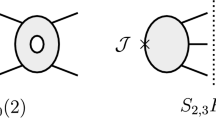Summary
The analysis begun in Part I of the conditions under which the regularization, performed by the adoption of the modified integrals introduced there, acts as a renormalization is completed. The «conditions of the second type» announced in I are formulated and discussed; a quantitative analysis may give results different from the standard requirements for renormalizability: as an example, it is shown that the neutral scalar meson theory is not renormalizable, contrary to current belief. The Lie equations of the renormalization group can be derived without difficulty, and their integrability conditions investigated. Finally, it is shown that using our modified integrals amounts to solving the differential branching equations for kernels under the condition that the solutions belong to a certain well-defined mathematical class . In this way, ultraviolet infinities never appear, and the search for the renormalizability conditions becomes a search for the self-consistency of a theory, which need be made once for all and cannot cause inconvenience in computations. The result is a rigorous mathematical formulation of the renormalized theory, which avoids all mentions of «bare particles», is completely rid of ambiguities and is suited both for practical computations and for the study of fundamental questions. The unphysical splitting of processes into Feynman graphs is avoided; the troubles due to overlaps are shown to have a trivial origin and are altogether eliminated; all vertex-part contributions vanish with this method, at least in electrodynamics, since the cancellation of them against electron self-energy contributions occurs prior to actual computation. These criteria will be applied in a forthcoming work to an exhaustive study of electrodynamics; they are expected to play a relevant rôle in a search for consistent theories of elementary particles.
. In this way, ultraviolet infinities never appear, and the search for the renormalizability conditions becomes a search for the self-consistency of a theory, which need be made once for all and cannot cause inconvenience in computations. The result is a rigorous mathematical formulation of the renormalized theory, which avoids all mentions of «bare particles», is completely rid of ambiguities and is suited both for practical computations and for the study of fundamental questions. The unphysical splitting of processes into Feynman graphs is avoided; the troubles due to overlaps are shown to have a trivial origin and are altogether eliminated; all vertex-part contributions vanish with this method, at least in electrodynamics, since the cancellation of them against electron self-energy contributions occurs prior to actual computation. These criteria will be applied in a forthcoming work to an exhaustive study of electrodynamics; they are expected to play a relevant rôle in a search for consistent theories of elementary particles.
Riassunto
Viene completata l’analisi, iniziata nella parte I, delle condizioni sotto cui la regolarizzazione, ottenuta con l’adozione degli integrali modificati introdotti nella parte I, equivale ad una rinormalizzazione. Le condizioni del secondo tipo annunciate in I sono formulate e discusse; un’analisi quantitativa può fornire risultati differenti dai requisiti usuali per la rinormalizzazione; come ad esempio si mostra che la teoria mesonica scalare neutra non è rinormalizzabile, contrariamente all’opinione corrente. Senza difficoltà si possono dedurre le equazioni di Lie del gruppo di rinormalizzazione e si può indagare sule loro condizioni di integrabilità. Infine si mostra che usare i nostri integrali modificati equivale a risolvere le equazioni differenziali di diramazione per i nuclei con la condizione che le soluzioni appartengano ad una certa classe matematica ben definita . In questo modo gli infiniti ultravioletti non compaiono più, e la ricerca di condizioni di rinormalizzabilità diventa una ricerca dell’autoconsistenza di una teoria, che deve essere fatta una volta per tutte e non può causare inconvenienti nei calcoli. Il risultato è una formulazione rigorosa della teoria rinormalizzata che evita ogni menzione di «particelle nude», è completamente libera da ambiguità ed è adatta sia per calcoli pratici che per lo studio delle equazioni fondamentali. Viene evitata la suddivisione non fisica dei processi in diagrammi di Feynman; si mostra che le difficotà dovute alle sovrapposizioni hanno un’origine banale e sono completamente eliminate; tutti i contributi dovuti alla parte di vertice si annullano con questo metodo, almeno in elettrodinamica, poichè si verifica l’eliminazione di essi, con i contributi dell’energia propria dell’elettrone, già prima dell’effettivo calcolo. Questi criteri saranno applicati in un prossimo lavoro ad uno studio esauriente dell’elettrodinamica; ci si aspetta che tali criteri giuochino un ruolo rilevante in una ricerca delle teorie consistenti delle particelle elementari.
. In questo modo gli infiniti ultravioletti non compaiono più, e la ricerca di condizioni di rinormalizzabilità diventa una ricerca dell’autoconsistenza di una teoria, che deve essere fatta una volta per tutte e non può causare inconvenienti nei calcoli. Il risultato è una formulazione rigorosa della teoria rinormalizzata che evita ogni menzione di «particelle nude», è completamente libera da ambiguità ed è adatta sia per calcoli pratici che per lo studio delle equazioni fondamentali. Viene evitata la suddivisione non fisica dei processi in diagrammi di Feynman; si mostra che le difficotà dovute alle sovrapposizioni hanno un’origine banale e sono completamente eliminate; tutti i contributi dovuti alla parte di vertice si annullano con questo metodo, almeno in elettrodinamica, poichè si verifica l’eliminazione di essi, con i contributi dell’energia propria dell’elettrone, già prima dell’effettivo calcolo. Questi criteri saranno applicati in un prossimo lavoro ad uno studio esauriente dell’elettrodinamica; ci si aspetta che tali criteri giuochino un ruolo rilevante in una ricerca delle teorie consistenti delle particelle elementari.
Similar content being viewed by others
Author information
Authors and Affiliations
Additional information
The research reported in this document has been sponsored in part by the Office, Chief of Research and Development, U.S. Department of Army.
Part of this research was performed at the Institut des Hautes Etudes Scientifiques, Paris. The author takes pleasure in thanking its Director,M. L. Motchane, for the kind hospitality extended to him.
Rights and permissions
About this article
Cite this article
Caianiello, E.R. Regularization and renormalization. Nuovo Cim 14, 185–210 (1959). https://doi.org/10.1007/BF02725018
Received:
Published:
Issue Date:
DOI: https://doi.org/10.1007/BF02725018




